Strategies for Creating an Inclusive Level Playing Field in Education
VerifiedAdded on 2023/06/17
|10
|3538
|243
Report
AI Summary
This report evaluates the factors impacting learning, including cultural, social, and personal aspects, alongside the influence of physical, cognitive, and sensory abilities. It delves into policy and regulatory frameworks related to inclusive practices, emphasizing the roles and responsibilities within such environments. The report identifies referral points to address individual learning needs and highlights the benefits of inclusive learning environments. Furthermore, it explores strategies to promote inclusion, equality, and diversity. The conclusion evaluates the effectiveness of personal inclusive practices, pinpointing strengths and areas for improvement, with a plan for enhancing inclusive practice skills. This document is available on Desklib, a platform offering a wide array of study tools and solved assignments for students.
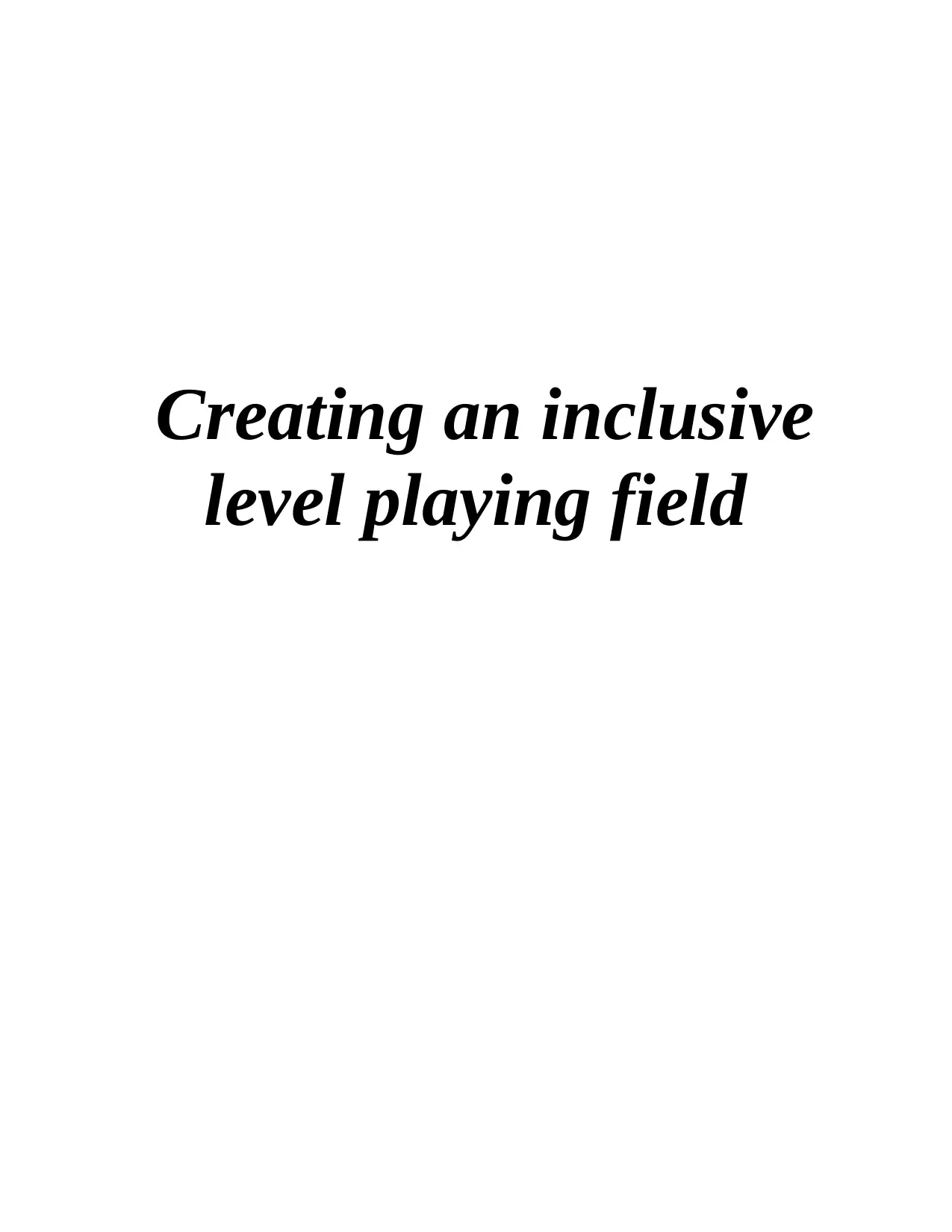
Creating an inclusive
level playing field
level playing field
Paraphrase This Document
Need a fresh take? Get an instant paraphrase of this document with our AI Paraphraser
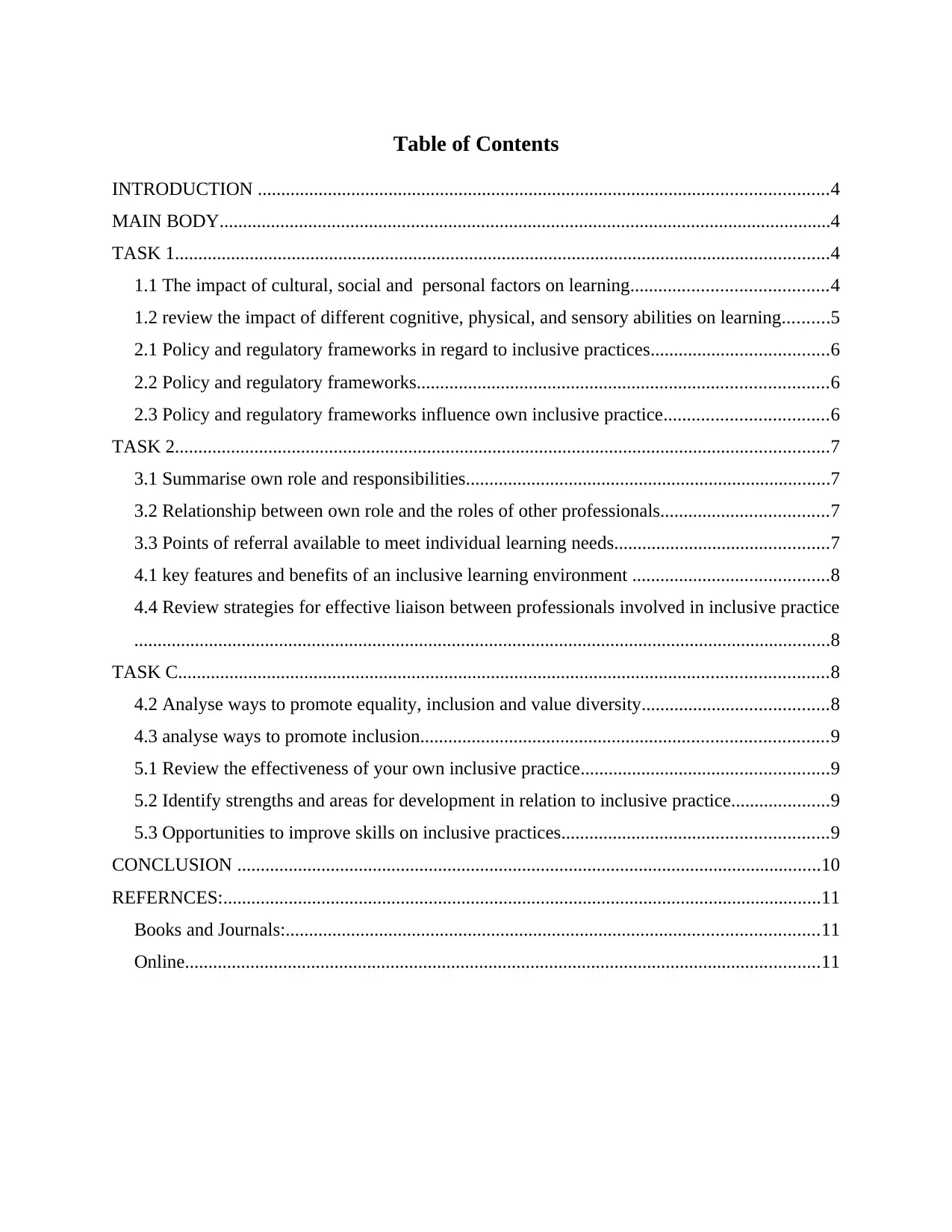
Table of Contents
INTRODUCTION ..........................................................................................................................4
MAIN BODY...................................................................................................................................4
TASK 1............................................................................................................................................4
1.1 The impact of cultural, social and personal factors on learning..........................................4
1.2 review the impact of different cognitive, physical, and sensory abilities on learning..........5
2.1 Policy and regulatory frameworks in regard to inclusive practices......................................6
2.2 Policy and regulatory frameworks........................................................................................6
2.3 Policy and regulatory frameworks influence own inclusive practice...................................6
TASK 2............................................................................................................................................7
3.1 Summarise own role and responsibilities..............................................................................7
3.2 Relationship between own role and the roles of other professionals....................................7
3.3 Points of referral available to meet individual learning needs..............................................7
4.1 key features and benefits of an inclusive learning environment ..........................................8
4.4 Review strategies for effective liaison between professionals involved in inclusive practice
.....................................................................................................................................................8
TASK C...........................................................................................................................................8
4.2 Analyse ways to promote equality, inclusion and value diversity........................................8
4.3 analyse ways to promote inclusion.......................................................................................9
5.1 Review the effectiveness of your own inclusive practice.....................................................9
5.2 Identify strengths and areas for development in relation to inclusive practice.....................9
5.3 Opportunities to improve skills on inclusive practices.........................................................9
CONCLUSION .............................................................................................................................10
REFERNCES:................................................................................................................................11
Books and Journals:..................................................................................................................11
Online........................................................................................................................................11
INTRODUCTION ..........................................................................................................................4
MAIN BODY...................................................................................................................................4
TASK 1............................................................................................................................................4
1.1 The impact of cultural, social and personal factors on learning..........................................4
1.2 review the impact of different cognitive, physical, and sensory abilities on learning..........5
2.1 Policy and regulatory frameworks in regard to inclusive practices......................................6
2.2 Policy and regulatory frameworks........................................................................................6
2.3 Policy and regulatory frameworks influence own inclusive practice...................................6
TASK 2............................................................................................................................................7
3.1 Summarise own role and responsibilities..............................................................................7
3.2 Relationship between own role and the roles of other professionals....................................7
3.3 Points of referral available to meet individual learning needs..............................................7
4.1 key features and benefits of an inclusive learning environment ..........................................8
4.4 Review strategies for effective liaison between professionals involved in inclusive practice
.....................................................................................................................................................8
TASK C...........................................................................................................................................8
4.2 Analyse ways to promote equality, inclusion and value diversity........................................8
4.3 analyse ways to promote inclusion.......................................................................................9
5.1 Review the effectiveness of your own inclusive practice.....................................................9
5.2 Identify strengths and areas for development in relation to inclusive practice.....................9
5.3 Opportunities to improve skills on inclusive practices.........................................................9
CONCLUSION .............................................................................................................................10
REFERNCES:................................................................................................................................11
Books and Journals:..................................................................................................................11
Online........................................................................................................................................11
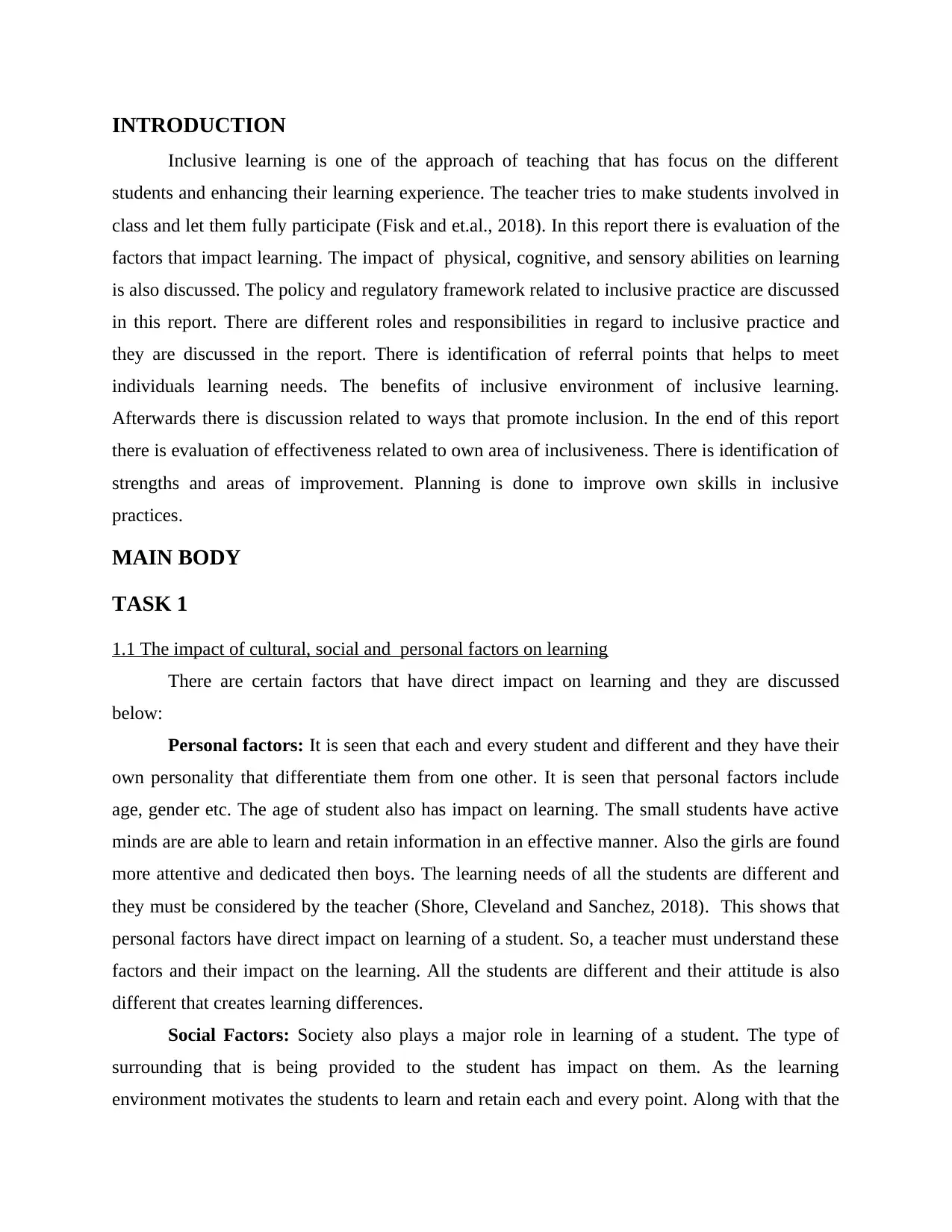
INTRODUCTION
Inclusive learning is one of the approach of teaching that has focus on the different
students and enhancing their learning experience. The teacher tries to make students involved in
class and let them fully participate (Fisk and et.al., 2018). In this report there is evaluation of the
factors that impact learning. The impact of physical, cognitive, and sensory abilities on learning
is also discussed. The policy and regulatory framework related to inclusive practice are discussed
in this report. There are different roles and responsibilities in regard to inclusive practice and
they are discussed in the report. There is identification of referral points that helps to meet
individuals learning needs. The benefits of inclusive environment of inclusive learning.
Afterwards there is discussion related to ways that promote inclusion. In the end of this report
there is evaluation of effectiveness related to own area of inclusiveness. There is identification of
strengths and areas of improvement. Planning is done to improve own skills in inclusive
practices.
MAIN BODY
TASK 1
1.1 The impact of cultural, social and personal factors on learning
There are certain factors that have direct impact on learning and they are discussed
below:
Personal factors: It is seen that each and every student and different and they have their
own personality that differentiate them from one other. It is seen that personal factors include
age, gender etc. The age of student also has impact on learning. The small students have active
minds are are able to learn and retain information in an effective manner. Also the girls are found
more attentive and dedicated then boys. The learning needs of all the students are different and
they must be considered by the teacher (Shore, Cleveland and Sanchez, 2018). This shows that
personal factors have direct impact on learning of a student. So, a teacher must understand these
factors and their impact on the learning. All the students are different and their attitude is also
different that creates learning differences.
Social Factors: Society also plays a major role in learning of a student. The type of
surrounding that is being provided to the student has impact on them. As the learning
environment motivates the students to learn and retain each and every point. Along with that the
Inclusive learning is one of the approach of teaching that has focus on the different
students and enhancing their learning experience. The teacher tries to make students involved in
class and let them fully participate (Fisk and et.al., 2018). In this report there is evaluation of the
factors that impact learning. The impact of physical, cognitive, and sensory abilities on learning
is also discussed. The policy and regulatory framework related to inclusive practice are discussed
in this report. There are different roles and responsibilities in regard to inclusive practice and
they are discussed in the report. There is identification of referral points that helps to meet
individuals learning needs. The benefits of inclusive environment of inclusive learning.
Afterwards there is discussion related to ways that promote inclusion. In the end of this report
there is evaluation of effectiveness related to own area of inclusiveness. There is identification of
strengths and areas of improvement. Planning is done to improve own skills in inclusive
practices.
MAIN BODY
TASK 1
1.1 The impact of cultural, social and personal factors on learning
There are certain factors that have direct impact on learning and they are discussed
below:
Personal factors: It is seen that each and every student and different and they have their
own personality that differentiate them from one other. It is seen that personal factors include
age, gender etc. The age of student also has impact on learning. The small students have active
minds are are able to learn and retain information in an effective manner. Also the girls are found
more attentive and dedicated then boys. The learning needs of all the students are different and
they must be considered by the teacher (Shore, Cleveland and Sanchez, 2018). This shows that
personal factors have direct impact on learning of a student. So, a teacher must understand these
factors and their impact on the learning. All the students are different and their attitude is also
different that creates learning differences.
Social Factors: Society also plays a major role in learning of a student. The type of
surrounding that is being provided to the student has impact on them. As the learning
environment motivates the students to learn and retain each and every point. Along with that the
⊘ This is a preview!⊘
Do you want full access?
Subscribe today to unlock all pages.

Trusted by 1+ million students worldwide
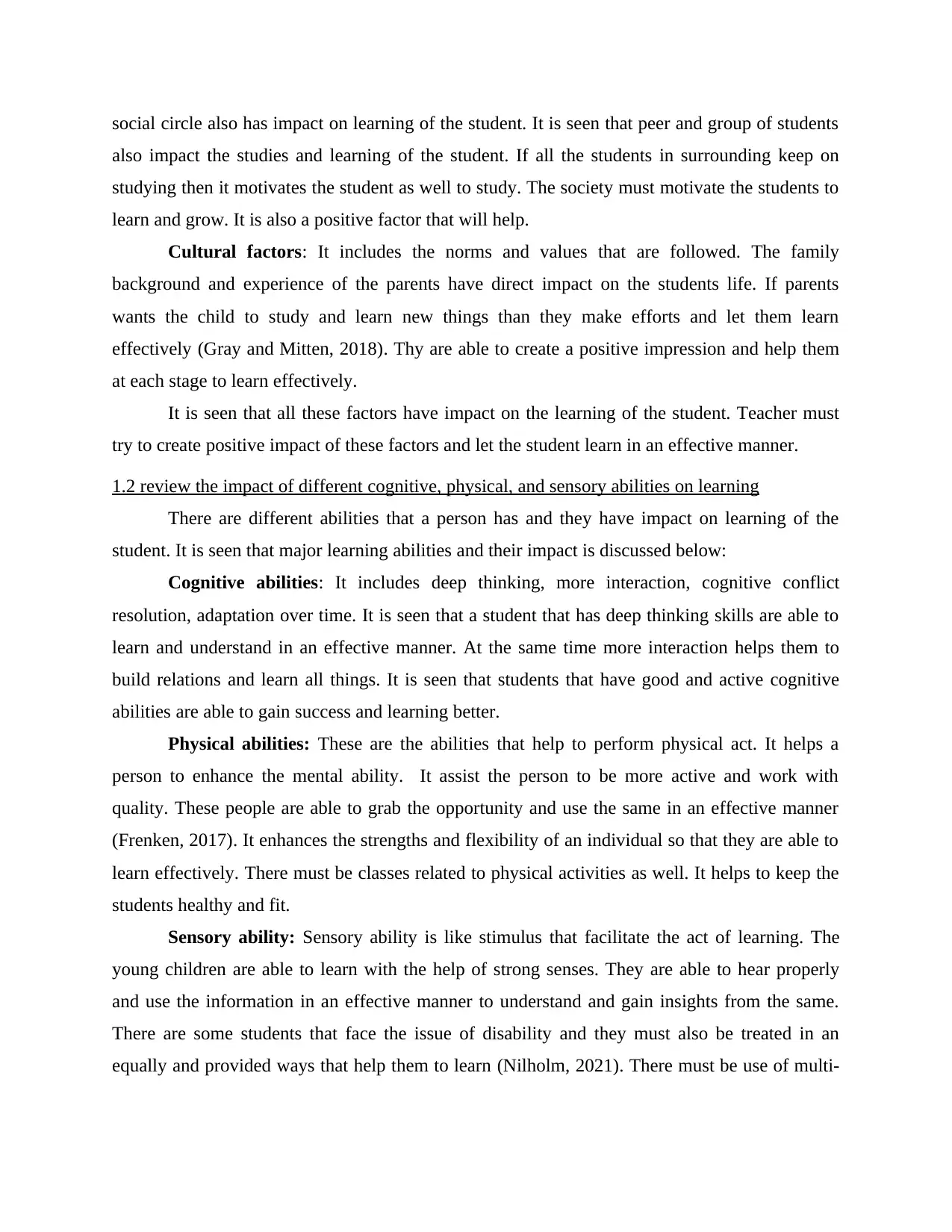
social circle also has impact on learning of the student. It is seen that peer and group of students
also impact the studies and learning of the student. If all the students in surrounding keep on
studying then it motivates the student as well to study. The society must motivate the students to
learn and grow. It is also a positive factor that will help.
Cultural factors: It includes the norms and values that are followed. The family
background and experience of the parents have direct impact on the students life. If parents
wants the child to study and learn new things than they make efforts and let them learn
effectively (Gray and Mitten, 2018). Thy are able to create a positive impression and help them
at each stage to learn effectively.
It is seen that all these factors have impact on the learning of the student. Teacher must
try to create positive impact of these factors and let the student learn in an effective manner.
1.2 review the impact of different cognitive, physical, and sensory abilities on learning
There are different abilities that a person has and they have impact on learning of the
student. It is seen that major learning abilities and their impact is discussed below:
Cognitive abilities: It includes deep thinking, more interaction, cognitive conflict
resolution, adaptation over time. It is seen that a student that has deep thinking skills are able to
learn and understand in an effective manner. At the same time more interaction helps them to
build relations and learn all things. It is seen that students that have good and active cognitive
abilities are able to gain success and learning better.
Physical abilities: These are the abilities that help to perform physical act. It helps a
person to enhance the mental ability. It assist the person to be more active and work with
quality. These people are able to grab the opportunity and use the same in an effective manner
(Frenken, 2017). It enhances the strengths and flexibility of an individual so that they are able to
learn effectively. There must be classes related to physical activities as well. It helps to keep the
students healthy and fit.
Sensory ability: Sensory ability is like stimulus that facilitate the act of learning. The
young children are able to learn with the help of strong senses. They are able to hear properly
and use the information in an effective manner to understand and gain insights from the same.
There are some students that face the issue of disability and they must also be treated in an
equally and provided ways that help them to learn (Nilholm, 2021). There must be use of multi-
also impact the studies and learning of the student. If all the students in surrounding keep on
studying then it motivates the student as well to study. The society must motivate the students to
learn and grow. It is also a positive factor that will help.
Cultural factors: It includes the norms and values that are followed. The family
background and experience of the parents have direct impact on the students life. If parents
wants the child to study and learn new things than they make efforts and let them learn
effectively (Gray and Mitten, 2018). Thy are able to create a positive impression and help them
at each stage to learn effectively.
It is seen that all these factors have impact on the learning of the student. Teacher must
try to create positive impact of these factors and let the student learn in an effective manner.
1.2 review the impact of different cognitive, physical, and sensory abilities on learning
There are different abilities that a person has and they have impact on learning of the
student. It is seen that major learning abilities and their impact is discussed below:
Cognitive abilities: It includes deep thinking, more interaction, cognitive conflict
resolution, adaptation over time. It is seen that a student that has deep thinking skills are able to
learn and understand in an effective manner. At the same time more interaction helps them to
build relations and learn all things. It is seen that students that have good and active cognitive
abilities are able to gain success and learning better.
Physical abilities: These are the abilities that help to perform physical act. It helps a
person to enhance the mental ability. It assist the person to be more active and work with
quality. These people are able to grab the opportunity and use the same in an effective manner
(Frenken, 2017). It enhances the strengths and flexibility of an individual so that they are able to
learn effectively. There must be classes related to physical activities as well. It helps to keep the
students healthy and fit.
Sensory ability: Sensory ability is like stimulus that facilitate the act of learning. The
young children are able to learn with the help of strong senses. They are able to hear properly
and use the information in an effective manner to understand and gain insights from the same.
There are some students that face the issue of disability and they must also be treated in an
equally and provided ways that help them to learn (Nilholm, 2021). There must be use of multi-
Paraphrase This Document
Need a fresh take? Get an instant paraphrase of this document with our AI Paraphraser
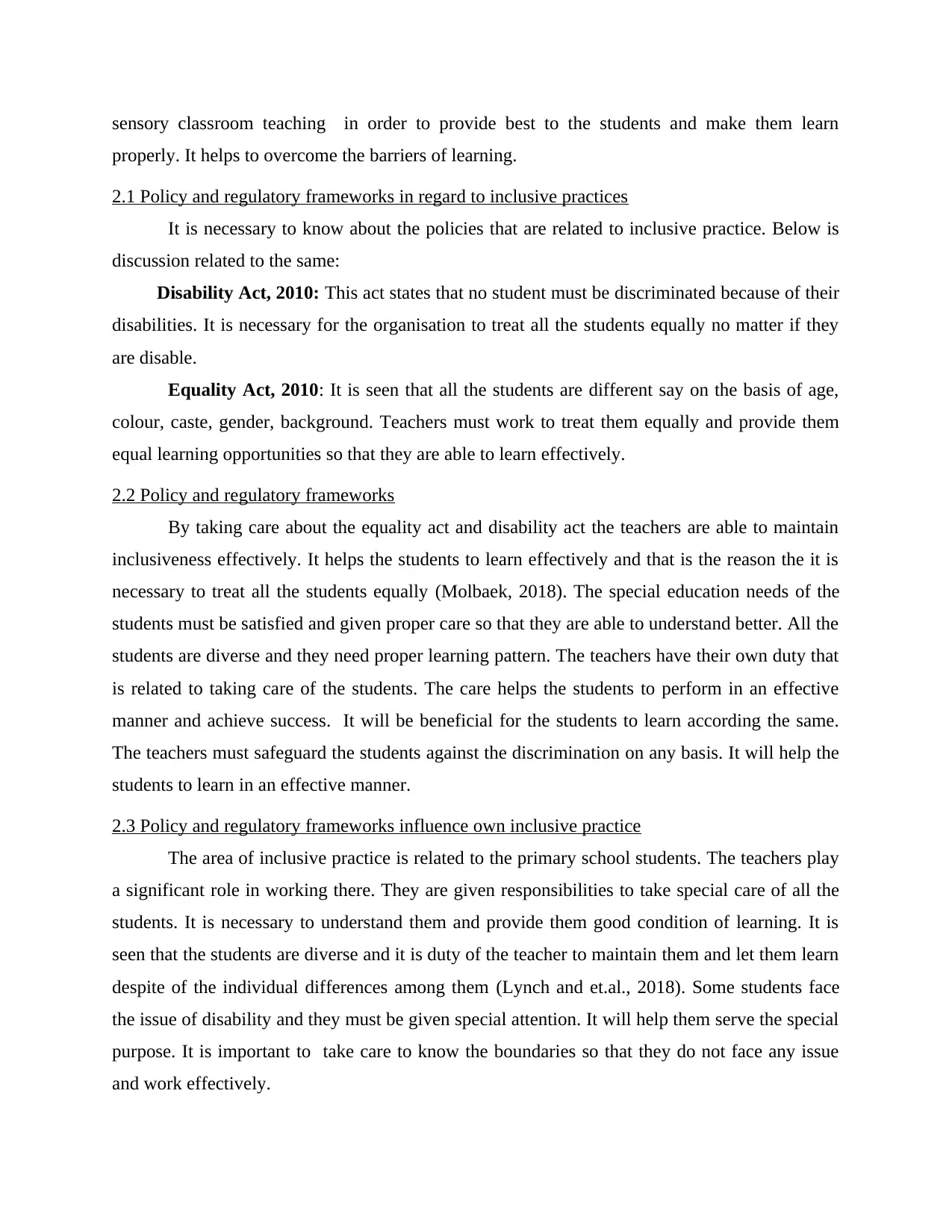
sensory classroom teaching in order to provide best to the students and make them learn
properly. It helps to overcome the barriers of learning.
2.1 Policy and regulatory frameworks in regard to inclusive practices
It is necessary to know about the policies that are related to inclusive practice. Below is
discussion related to the same:
Disability Act, 2010: This act states that no student must be discriminated because of their
disabilities. It is necessary for the organisation to treat all the students equally no matter if they
are disable.
Equality Act, 2010: It is seen that all the students are different say on the basis of age,
colour, caste, gender, background. Teachers must work to treat them equally and provide them
equal learning opportunities so that they are able to learn effectively.
2.2 Policy and regulatory frameworks
By taking care about the equality act and disability act the teachers are able to maintain
inclusiveness effectively. It helps the students to learn effectively and that is the reason the it is
necessary to treat all the students equally (Molbaek, 2018). The special education needs of the
students must be satisfied and given proper care so that they are able to understand better. All the
students are diverse and they need proper learning pattern. The teachers have their own duty that
is related to taking care of the students. The care helps the students to perform in an effective
manner and achieve success. It will be beneficial for the students to learn according the same.
The teachers must safeguard the students against the discrimination on any basis. It will help the
students to learn in an effective manner.
2.3 Policy and regulatory frameworks influence own inclusive practice
The area of inclusive practice is related to the primary school students. The teachers play
a significant role in working there. They are given responsibilities to take special care of all the
students. It is necessary to understand them and provide them good condition of learning. It is
seen that the students are diverse and it is duty of the teacher to maintain them and let them learn
despite of the individual differences among them (Lynch and et.al., 2018). Some students face
the issue of disability and they must be given special attention. It will help them serve the special
purpose. It is important to take care to know the boundaries so that they do not face any issue
and work effectively.
properly. It helps to overcome the barriers of learning.
2.1 Policy and regulatory frameworks in regard to inclusive practices
It is necessary to know about the policies that are related to inclusive practice. Below is
discussion related to the same:
Disability Act, 2010: This act states that no student must be discriminated because of their
disabilities. It is necessary for the organisation to treat all the students equally no matter if they
are disable.
Equality Act, 2010: It is seen that all the students are different say on the basis of age,
colour, caste, gender, background. Teachers must work to treat them equally and provide them
equal learning opportunities so that they are able to learn effectively.
2.2 Policy and regulatory frameworks
By taking care about the equality act and disability act the teachers are able to maintain
inclusiveness effectively. It helps the students to learn effectively and that is the reason the it is
necessary to treat all the students equally (Molbaek, 2018). The special education needs of the
students must be satisfied and given proper care so that they are able to understand better. All the
students are diverse and they need proper learning pattern. The teachers have their own duty that
is related to taking care of the students. The care helps the students to perform in an effective
manner and achieve success. It will be beneficial for the students to learn according the same.
The teachers must safeguard the students against the discrimination on any basis. It will help the
students to learn in an effective manner.
2.3 Policy and regulatory frameworks influence own inclusive practice
The area of inclusive practice is related to the primary school students. The teachers play
a significant role in working there. They are given responsibilities to take special care of all the
students. It is necessary to understand them and provide them good condition of learning. It is
seen that the students are diverse and it is duty of the teacher to maintain them and let them learn
despite of the individual differences among them (Lynch and et.al., 2018). Some students face
the issue of disability and they must be given special attention. It will help them serve the special
purpose. It is important to take care to know the boundaries so that they do not face any issue
and work effectively.
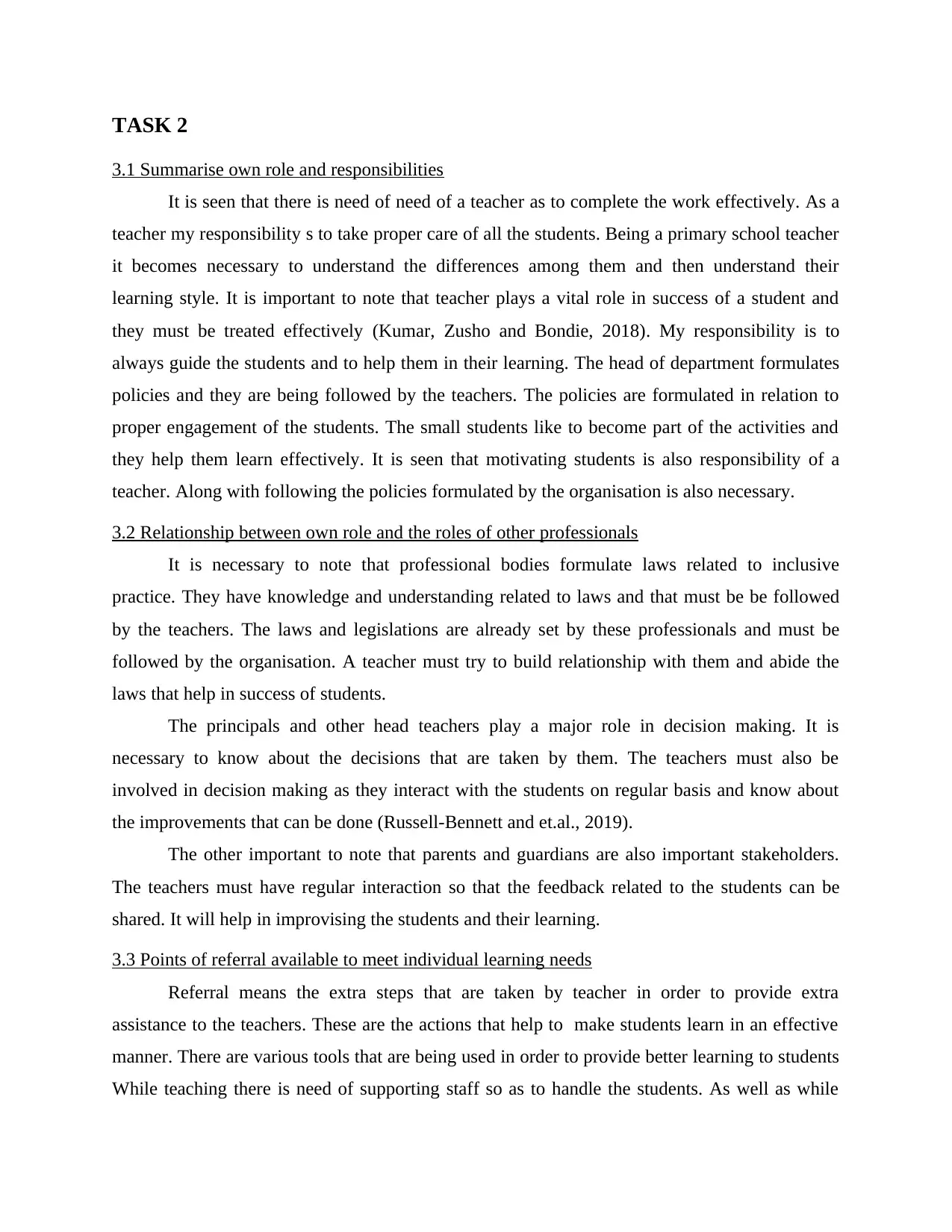
TASK 2
3.1 Summarise own role and responsibilities
It is seen that there is need of need of a teacher as to complete the work effectively. As a
teacher my responsibility s to take proper care of all the students. Being a primary school teacher
it becomes necessary to understand the differences among them and then understand their
learning style. It is important to note that teacher plays a vital role in success of a student and
they must be treated effectively (Kumar, Zusho and Bondie, 2018). My responsibility is to
always guide the students and to help them in their learning. The head of department formulates
policies and they are being followed by the teachers. The policies are formulated in relation to
proper engagement of the students. The small students like to become part of the activities and
they help them learn effectively. It is seen that motivating students is also responsibility of a
teacher. Along with following the policies formulated by the organisation is also necessary.
3.2 Relationship between own role and the roles of other professionals
It is necessary to note that professional bodies formulate laws related to inclusive
practice. They have knowledge and understanding related to laws and that must be be followed
by the teachers. The laws and legislations are already set by these professionals and must be
followed by the organisation. A teacher must try to build relationship with them and abide the
laws that help in success of students.
The principals and other head teachers play a major role in decision making. It is
necessary to know about the decisions that are taken by them. The teachers must also be
involved in decision making as they interact with the students on regular basis and know about
the improvements that can be done (Russell-Bennett and et.al., 2019).
The other important to note that parents and guardians are also important stakeholders.
The teachers must have regular interaction so that the feedback related to the students can be
shared. It will help in improvising the students and their learning.
3.3 Points of referral available to meet individual learning needs
Referral means the extra steps that are taken by teacher in order to provide extra
assistance to the teachers. These are the actions that help to make students learn in an effective
manner. There are various tools that are being used in order to provide better learning to students
While teaching there is need of supporting staff so as to handle the students. As well as while
3.1 Summarise own role and responsibilities
It is seen that there is need of need of a teacher as to complete the work effectively. As a
teacher my responsibility s to take proper care of all the students. Being a primary school teacher
it becomes necessary to understand the differences among them and then understand their
learning style. It is important to note that teacher plays a vital role in success of a student and
they must be treated effectively (Kumar, Zusho and Bondie, 2018). My responsibility is to
always guide the students and to help them in their learning. The head of department formulates
policies and they are being followed by the teachers. The policies are formulated in relation to
proper engagement of the students. The small students like to become part of the activities and
they help them learn effectively. It is seen that motivating students is also responsibility of a
teacher. Along with following the policies formulated by the organisation is also necessary.
3.2 Relationship between own role and the roles of other professionals
It is necessary to note that professional bodies formulate laws related to inclusive
practice. They have knowledge and understanding related to laws and that must be be followed
by the teachers. The laws and legislations are already set by these professionals and must be
followed by the organisation. A teacher must try to build relationship with them and abide the
laws that help in success of students.
The principals and other head teachers play a major role in decision making. It is
necessary to know about the decisions that are taken by them. The teachers must also be
involved in decision making as they interact with the students on regular basis and know about
the improvements that can be done (Russell-Bennett and et.al., 2019).
The other important to note that parents and guardians are also important stakeholders.
The teachers must have regular interaction so that the feedback related to the students can be
shared. It will help in improvising the students and their learning.
3.3 Points of referral available to meet individual learning needs
Referral means the extra steps that are taken by teacher in order to provide extra
assistance to the teachers. These are the actions that help to make students learn in an effective
manner. There are various tools that are being used in order to provide better learning to students
While teaching there is need of supporting staff so as to handle the students. As well as while
⊘ This is a preview!⊘
Do you want full access?
Subscribe today to unlock all pages.

Trusted by 1+ million students worldwide
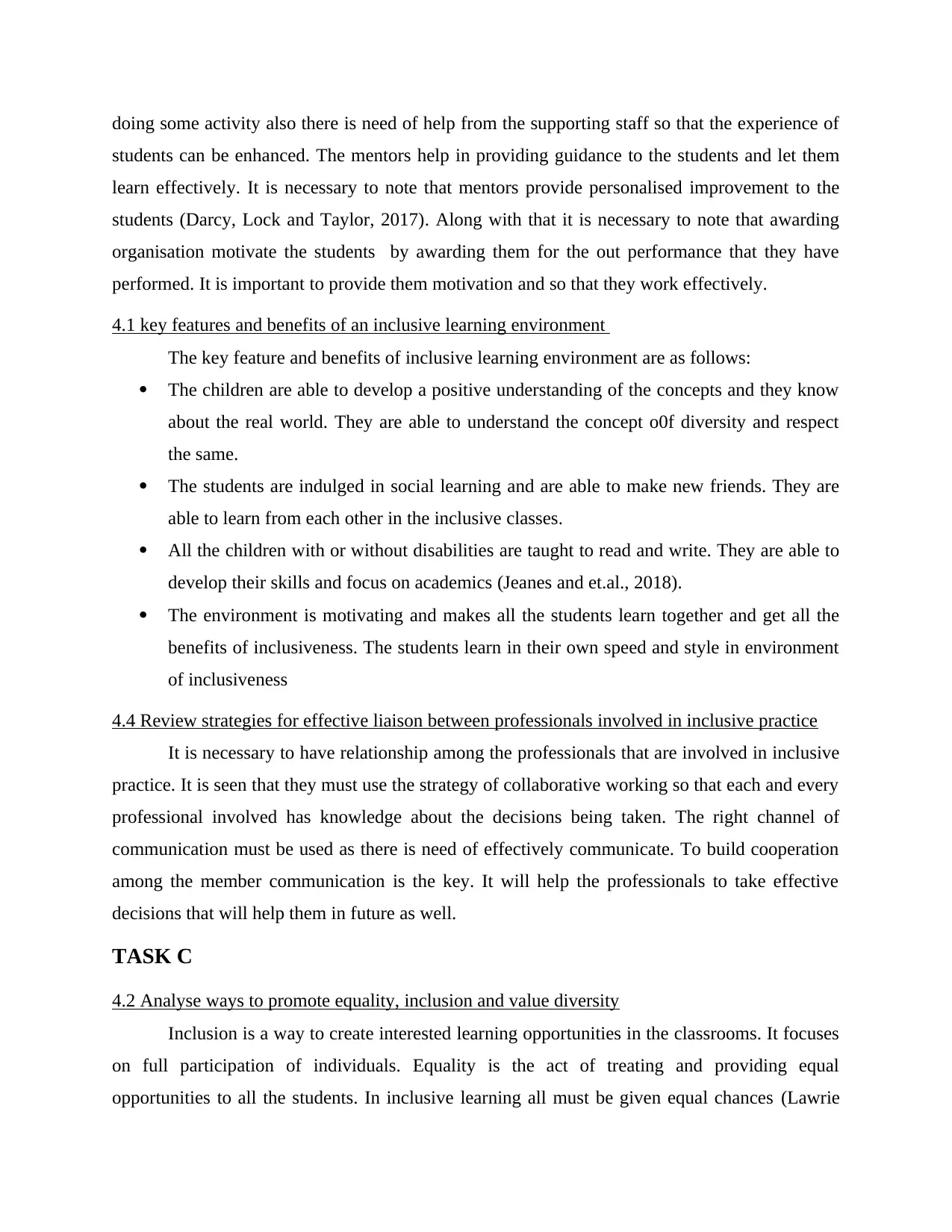
doing some activity also there is need of help from the supporting staff so that the experience of
students can be enhanced. The mentors help in providing guidance to the students and let them
learn effectively. It is necessary to note that mentors provide personalised improvement to the
students (Darcy, Lock and Taylor, 2017). Along with that it is necessary to note that awarding
organisation motivate the students by awarding them for the out performance that they have
performed. It is important to provide them motivation and so that they work effectively.
4.1 key features and benefits of an inclusive learning environment
The key feature and benefits of inclusive learning environment are as follows:
The children are able to develop a positive understanding of the concepts and they know
about the real world. They are able to understand the concept o0f diversity and respect
the same.
The students are indulged in social learning and are able to make new friends. They are
able to learn from each other in the inclusive classes.
All the children with or without disabilities are taught to read and write. They are able to
develop their skills and focus on academics (Jeanes and et.al., 2018).
The environment is motivating and makes all the students learn together and get all the
benefits of inclusiveness. The students learn in their own speed and style in environment
of inclusiveness
4.4 Review strategies for effective liaison between professionals involved in inclusive practice
It is necessary to have relationship among the professionals that are involved in inclusive
practice. It is seen that they must use the strategy of collaborative working so that each and every
professional involved has knowledge about the decisions being taken. The right channel of
communication must be used as there is need of effectively communicate. To build cooperation
among the member communication is the key. It will help the professionals to take effective
decisions that will help them in future as well.
TASK C
4.2 Analyse ways to promote equality, inclusion and value diversity
Inclusion is a way to create interested learning opportunities in the classrooms. It focuses
on full participation of individuals. Equality is the act of treating and providing equal
opportunities to all the students. In inclusive learning all must be given equal chances (Lawrie
students can be enhanced. The mentors help in providing guidance to the students and let them
learn effectively. It is necessary to note that mentors provide personalised improvement to the
students (Darcy, Lock and Taylor, 2017). Along with that it is necessary to note that awarding
organisation motivate the students by awarding them for the out performance that they have
performed. It is important to provide them motivation and so that they work effectively.
4.1 key features and benefits of an inclusive learning environment
The key feature and benefits of inclusive learning environment are as follows:
The children are able to develop a positive understanding of the concepts and they know
about the real world. They are able to understand the concept o0f diversity and respect
the same.
The students are indulged in social learning and are able to make new friends. They are
able to learn from each other in the inclusive classes.
All the children with or without disabilities are taught to read and write. They are able to
develop their skills and focus on academics (Jeanes and et.al., 2018).
The environment is motivating and makes all the students learn together and get all the
benefits of inclusiveness. The students learn in their own speed and style in environment
of inclusiveness
4.4 Review strategies for effective liaison between professionals involved in inclusive practice
It is necessary to have relationship among the professionals that are involved in inclusive
practice. It is seen that they must use the strategy of collaborative working so that each and every
professional involved has knowledge about the decisions being taken. The right channel of
communication must be used as there is need of effectively communicate. To build cooperation
among the member communication is the key. It will help the professionals to take effective
decisions that will help them in future as well.
TASK C
4.2 Analyse ways to promote equality, inclusion and value diversity
Inclusion is a way to create interested learning opportunities in the classrooms. It focuses
on full participation of individuals. Equality is the act of treating and providing equal
opportunities to all the students. In inclusive learning all must be given equal chances (Lawrie
Paraphrase This Document
Need a fresh take? Get an instant paraphrase of this document with our AI Paraphraser
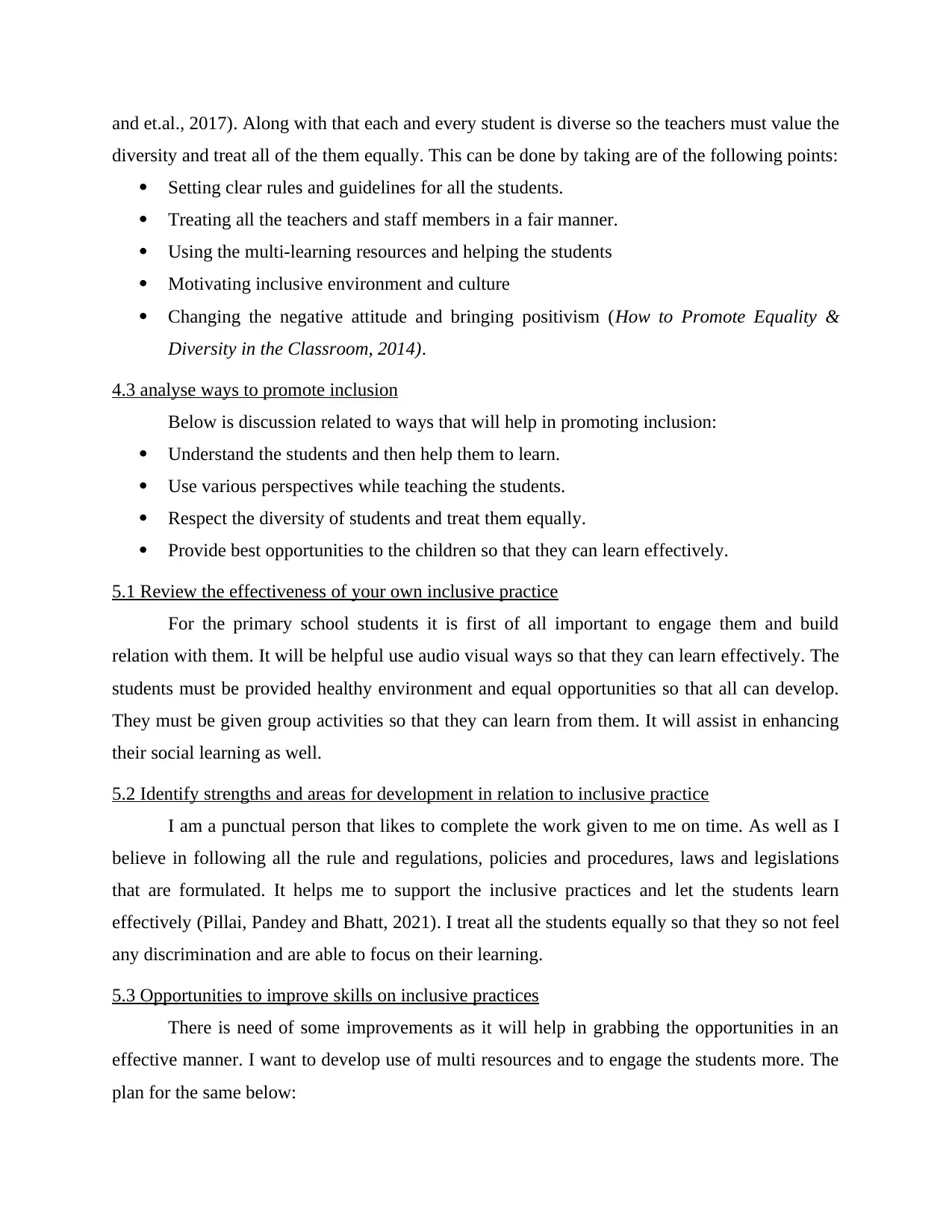
and et.al., 2017). Along with that each and every student is diverse so the teachers must value the
diversity and treat all of the them equally. This can be done by taking are of the following points:
Setting clear rules and guidelines for all the students.
Treating all the teachers and staff members in a fair manner.
Using the multi-learning resources and helping the students
Motivating inclusive environment and culture
Changing the negative attitude and bringing positivism (How to Promote Equality &
Diversity in the Classroom, 2014).
4.3 analyse ways to promote inclusion
Below is discussion related to ways that will help in promoting inclusion:
Understand the students and then help them to learn.
Use various perspectives while teaching the students.
Respect the diversity of students and treat them equally.
Provide best opportunities to the children so that they can learn effectively.
5.1 Review the effectiveness of your own inclusive practice
For the primary school students it is first of all important to engage them and build
relation with them. It will be helpful use audio visual ways so that they can learn effectively. The
students must be provided healthy environment and equal opportunities so that all can develop.
They must be given group activities so that they can learn from them. It will assist in enhancing
their social learning as well.
5.2 Identify strengths and areas for development in relation to inclusive practice
I am a punctual person that likes to complete the work given to me on time. As well as I
believe in following all the rule and regulations, policies and procedures, laws and legislations
that are formulated. It helps me to support the inclusive practices and let the students learn
effectively (Pillai, Pandey and Bhatt, 2021). I treat all the students equally so that they so not feel
any discrimination and are able to focus on their learning.
5.3 Opportunities to improve skills on inclusive practices
There is need of some improvements as it will help in grabbing the opportunities in an
effective manner. I want to develop use of multi resources and to engage the students more. The
plan for the same below:
diversity and treat all of the them equally. This can be done by taking are of the following points:
Setting clear rules and guidelines for all the students.
Treating all the teachers and staff members in a fair manner.
Using the multi-learning resources and helping the students
Motivating inclusive environment and culture
Changing the negative attitude and bringing positivism (How to Promote Equality &
Diversity in the Classroom, 2014).
4.3 analyse ways to promote inclusion
Below is discussion related to ways that will help in promoting inclusion:
Understand the students and then help them to learn.
Use various perspectives while teaching the students.
Respect the diversity of students and treat them equally.
Provide best opportunities to the children so that they can learn effectively.
5.1 Review the effectiveness of your own inclusive practice
For the primary school students it is first of all important to engage them and build
relation with them. It will be helpful use audio visual ways so that they can learn effectively. The
students must be provided healthy environment and equal opportunities so that all can develop.
They must be given group activities so that they can learn from them. It will assist in enhancing
their social learning as well.
5.2 Identify strengths and areas for development in relation to inclusive practice
I am a punctual person that likes to complete the work given to me on time. As well as I
believe in following all the rule and regulations, policies and procedures, laws and legislations
that are formulated. It helps me to support the inclusive practices and let the students learn
effectively (Pillai, Pandey and Bhatt, 2021). I treat all the students equally so that they so not feel
any discrimination and are able to focus on their learning.
5.3 Opportunities to improve skills on inclusive practices
There is need of some improvements as it will help in grabbing the opportunities in an
effective manner. I want to develop use of multi resources and to engage the students more. The
plan for the same below:
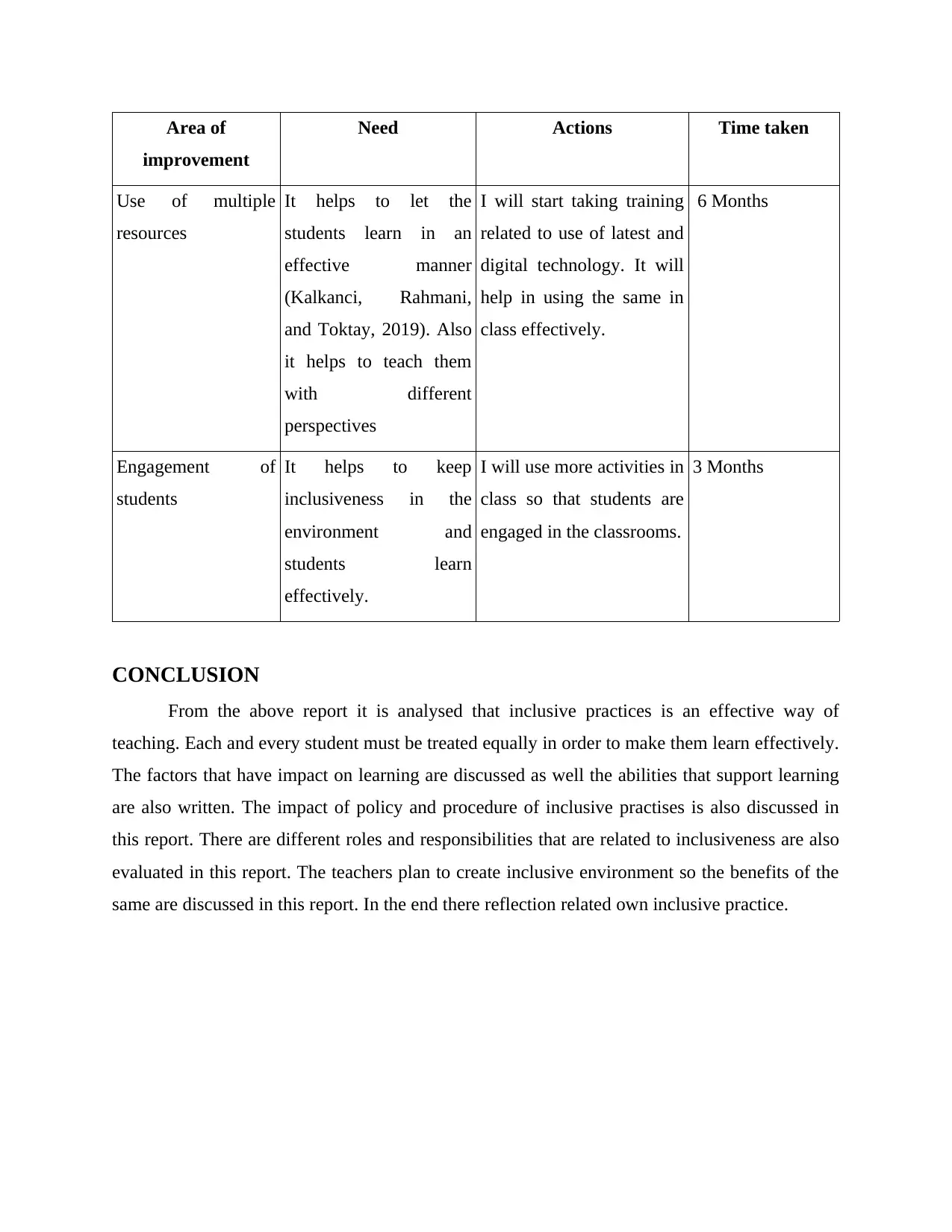
Area of
improvement
Need Actions Time taken
Use of multiple
resources
It helps to let the
students learn in an
effective manner
(Kalkanci, Rahmani,
and Toktay, 2019). Also
it helps to teach them
with different
perspectives
I will start taking training
related to use of latest and
digital technology. It will
help in using the same in
class effectively.
6 Months
Engagement of
students
It helps to keep
inclusiveness in the
environment and
students learn
effectively.
I will use more activities in
class so that students are
engaged in the classrooms.
3 Months
CONCLUSION
From the above report it is analysed that inclusive practices is an effective way of
teaching. Each and every student must be treated equally in order to make them learn effectively.
The factors that have impact on learning are discussed as well the abilities that support learning
are also written. The impact of policy and procedure of inclusive practises is also discussed in
this report. There are different roles and responsibilities that are related to inclusiveness are also
evaluated in this report. The teachers plan to create inclusive environment so the benefits of the
same are discussed in this report. In the end there reflection related own inclusive practice.
improvement
Need Actions Time taken
Use of multiple
resources
It helps to let the
students learn in an
effective manner
(Kalkanci, Rahmani,
and Toktay, 2019). Also
it helps to teach them
with different
perspectives
I will start taking training
related to use of latest and
digital technology. It will
help in using the same in
class effectively.
6 Months
Engagement of
students
It helps to keep
inclusiveness in the
environment and
students learn
effectively.
I will use more activities in
class so that students are
engaged in the classrooms.
3 Months
CONCLUSION
From the above report it is analysed that inclusive practices is an effective way of
teaching. Each and every student must be treated equally in order to make them learn effectively.
The factors that have impact on learning are discussed as well the abilities that support learning
are also written. The impact of policy and procedure of inclusive practises is also discussed in
this report. There are different roles and responsibilities that are related to inclusiveness are also
evaluated in this report. The teachers plan to create inclusive environment so the benefits of the
same are discussed in this report. In the end there reflection related own inclusive practice.
⊘ This is a preview!⊘
Do you want full access?
Subscribe today to unlock all pages.

Trusted by 1+ million students worldwide
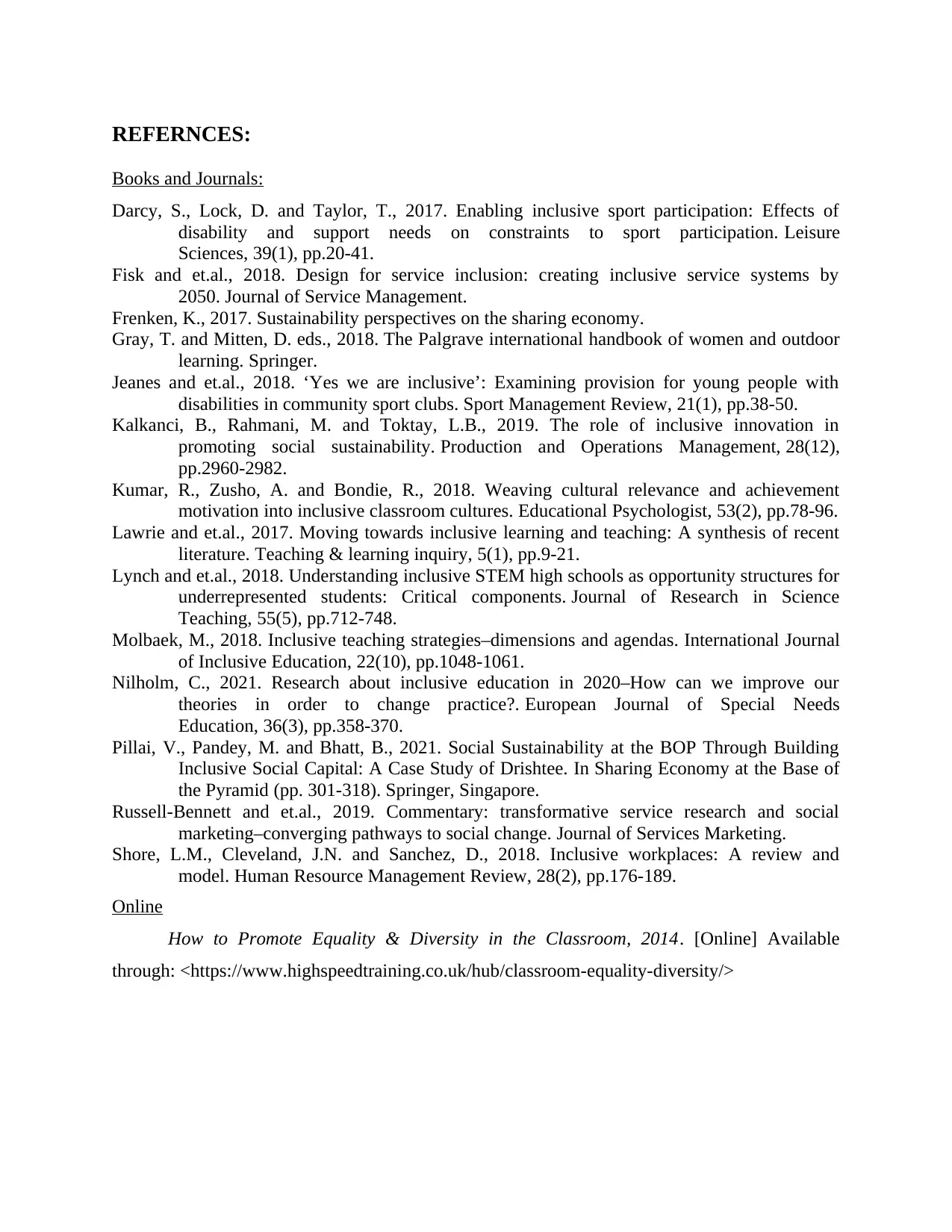
REFERNCES:
Books and Journals:
Darcy, S., Lock, D. and Taylor, T., 2017. Enabling inclusive sport participation: Effects of
disability and support needs on constraints to sport participation. Leisure
Sciences, 39(1), pp.20-41.
Fisk and et.al., 2018. Design for service inclusion: creating inclusive service systems by
2050. Journal of Service Management.
Frenken, K., 2017. Sustainability perspectives on the sharing economy.
Gray, T. and Mitten, D. eds., 2018. The Palgrave international handbook of women and outdoor
learning. Springer.
Jeanes and et.al., 2018. ‘Yes we are inclusive’: Examining provision for young people with
disabilities in community sport clubs. Sport Management Review, 21(1), pp.38-50.
Kalkanci, B., Rahmani, M. and Toktay, L.B., 2019. The role of inclusive innovation in
promoting social sustainability. Production and Operations Management, 28(12),
pp.2960-2982.
Kumar, R., Zusho, A. and Bondie, R., 2018. Weaving cultural relevance and achievement
motivation into inclusive classroom cultures. Educational Psychologist, 53(2), pp.78-96.
Lawrie and et.al., 2017. Moving towards inclusive learning and teaching: A synthesis of recent
literature. Teaching & learning inquiry, 5(1), pp.9-21.
Lynch and et.al., 2018. Understanding inclusive STEM high schools as opportunity structures for
underrepresented students: Critical components. Journal of Research in Science
Teaching, 55(5), pp.712-748.
Molbaek, M., 2018. Inclusive teaching strategies–dimensions and agendas. International Journal
of Inclusive Education, 22(10), pp.1048-1061.
Nilholm, C., 2021. Research about inclusive education in 2020–How can we improve our
theories in order to change practice?. European Journal of Special Needs
Education, 36(3), pp.358-370.
Pillai, V., Pandey, M. and Bhatt, B., 2021. Social Sustainability at the BOP Through Building
Inclusive Social Capital: A Case Study of Drishtee. In Sharing Economy at the Base of
the Pyramid (pp. 301-318). Springer, Singapore.
Russell-Bennett and et.al., 2019. Commentary: transformative service research and social
marketing–converging pathways to social change. Journal of Services Marketing.
Shore, L.M., Cleveland, J.N. and Sanchez, D., 2018. Inclusive workplaces: A review and
model. Human Resource Management Review, 28(2), pp.176-189.
Online
How to Promote Equality & Diversity in the Classroom, 2014. [Online] Available
through: <https://www.highspeedtraining.co.uk/hub/classroom-equality-diversity/>
Books and Journals:
Darcy, S., Lock, D. and Taylor, T., 2017. Enabling inclusive sport participation: Effects of
disability and support needs on constraints to sport participation. Leisure
Sciences, 39(1), pp.20-41.
Fisk and et.al., 2018. Design for service inclusion: creating inclusive service systems by
2050. Journal of Service Management.
Frenken, K., 2017. Sustainability perspectives on the sharing economy.
Gray, T. and Mitten, D. eds., 2018. The Palgrave international handbook of women and outdoor
learning. Springer.
Jeanes and et.al., 2018. ‘Yes we are inclusive’: Examining provision for young people with
disabilities in community sport clubs. Sport Management Review, 21(1), pp.38-50.
Kalkanci, B., Rahmani, M. and Toktay, L.B., 2019. The role of inclusive innovation in
promoting social sustainability. Production and Operations Management, 28(12),
pp.2960-2982.
Kumar, R., Zusho, A. and Bondie, R., 2018. Weaving cultural relevance and achievement
motivation into inclusive classroom cultures. Educational Psychologist, 53(2), pp.78-96.
Lawrie and et.al., 2017. Moving towards inclusive learning and teaching: A synthesis of recent
literature. Teaching & learning inquiry, 5(1), pp.9-21.
Lynch and et.al., 2018. Understanding inclusive STEM high schools as opportunity structures for
underrepresented students: Critical components. Journal of Research in Science
Teaching, 55(5), pp.712-748.
Molbaek, M., 2018. Inclusive teaching strategies–dimensions and agendas. International Journal
of Inclusive Education, 22(10), pp.1048-1061.
Nilholm, C., 2021. Research about inclusive education in 2020–How can we improve our
theories in order to change practice?. European Journal of Special Needs
Education, 36(3), pp.358-370.
Pillai, V., Pandey, M. and Bhatt, B., 2021. Social Sustainability at the BOP Through Building
Inclusive Social Capital: A Case Study of Drishtee. In Sharing Economy at the Base of
the Pyramid (pp. 301-318). Springer, Singapore.
Russell-Bennett and et.al., 2019. Commentary: transformative service research and social
marketing–converging pathways to social change. Journal of Services Marketing.
Shore, L.M., Cleveland, J.N. and Sanchez, D., 2018. Inclusive workplaces: A review and
model. Human Resource Management Review, 28(2), pp.176-189.
Online
How to Promote Equality & Diversity in the Classroom, 2014. [Online] Available
through: <https://www.highspeedtraining.co.uk/hub/classroom-equality-diversity/>
1 out of 10
Related Documents
Your All-in-One AI-Powered Toolkit for Academic Success.
+13062052269
info@desklib.com
Available 24*7 on WhatsApp / Email
![[object Object]](/_next/static/media/star-bottom.7253800d.svg)
Unlock your academic potential
Copyright © 2020–2025 A2Z Services. All Rights Reserved. Developed and managed by ZUCOL.



